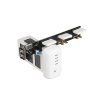From what I can determine, the P3 batteries won't allow a fast charge like other heli batteries. The electronics in the P3 batteries limit the charge rate, I think to about a 1C rate, which would be around 5A at 15.7V normal 4S rate (78W). There is no equalization connection to P3 batteries, as the electronics in the battery pack do that for you, apparently. As for the P3 connector, it's proprietary. I have also been looking to buy that connector with no luck so far, other than buying a
cheap P3 car charger for $20-25 just to get the connector. I have a
Hitec intelligent. 200W charger that's actually 4 independant chargers at 50W each. I like it because it's relatively fast (60-75 min charge) to charge all 4 batteries, and I don't have to closely monitor them. I charge them outside on my concrete counter-top BBQ island, pretty safe if something goes wrong. It's very convenient with my other quad batteries, however I need to find a source for the P3 battery connector. My P3 arrives today, so I will need these pretty soon. I may have to make the connectors myself, which I'd like to avoid if anyone knows where I can buy that connector.






